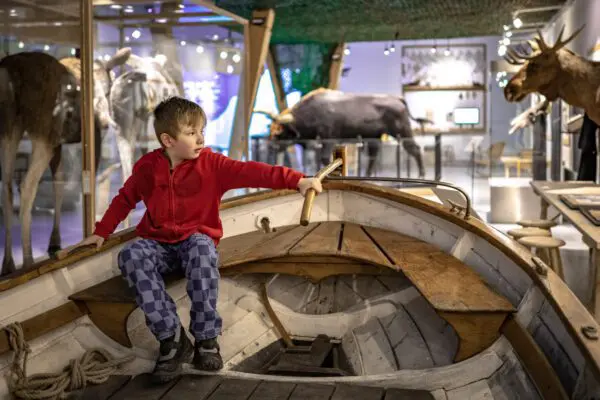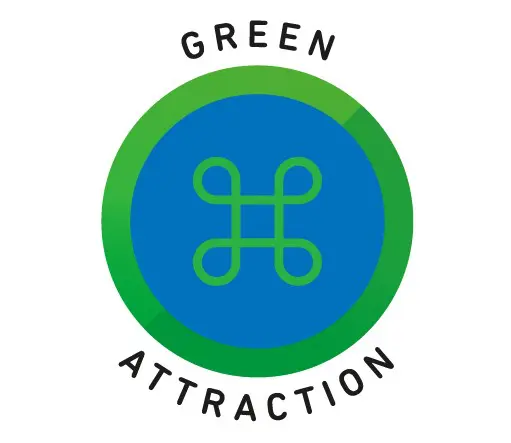Green Attraction
The name is compelling!
One of the most important agendas right now is undoubtedly sustainability.
Therefore, the Green Museum, as one of the country's first museums, has been certified as a Green Attraction in the spring of 2023.
This label was established by the industry organization HORESTA in collaboration with, among others, the Danish Museums Organization and is targeted at attractions. Green Attraction originated from Green Key, which is an independent international labeling scheme for hotels.
The Green Attraction certification requires us to register and measure our overall climate footprint in the future. Every year we must document that we comply with the label's sustainability criteria for all of the museum's work areas, and that we also work on how we involve guests, suppliers, volunteers and staff in our work.
Below you can read about some of the many areas where the museum focuses on sustainability:
Resource consumption
At the Green Museum, we are very aware of our use of resources. This is one of the reasons why we already have solar cells on the museum's roofs, both in the exhibition buildings on Randersvej and in our warehouse in Auning. The solar cells supply 51 % of our electricity consumption.
In recent years, we have continuously replaced lighting sources and have, among other things, installed energy-saving LED bulbs instead of regular bulbs in all installations where possible.
Even though we try to keep the amount down, both we and our guests still create a considerable amount of waste, which is sorted and subsequently included in the municipality's ordinary waste system, or is transported to the recycling station. As a guest, you help us when you make the effort to roughly sort waste in the Museum's waste bins.
The Agricultural Botanical Garden

The Agricultural Botanical Garden was established in 1993 and is a conservation center for old varieties of cultivated plants.
The Green Museum has a beautiful and unique agricultural botanical garden, with, among other things, 80 different types of rhubarb and over 400 apple trees. The garden was established in 1993 and is a conservation center for old varieties of cultivated plants. There are varieties from both fields and gardens, useful plants as well as ornamental plants, herbs, shrubs and trees.
As a guest at the museum, you are always welcome to taste fruits and vegetables – and you can do so with the best sustainable conscience. The Agricultural Botanical Garden, greenhouses, nursery and apple orchard are looked after by the Garden Team, which consists of 18 positions via an employment project. The Garden Team was established in collaboration between The Green Museum and Norddjurs municipality.
The Agricultural Botanical Garden is involved in the conservation work in collaboration with the Royal Danish Veterinary and Agricultural University in Copenhagen, Pometet in Høje Tåstrup and NordGen in Sweden.
Organic Agriculture
The Green Museum cultivates over 60 hectares of agricultural land laid out with grain and grass for livestock. Our agriculture is organic, and none of our areas are worked with pesticides. It does involve a little extra work, but the museum farmer has, among other things, started an experiment in 2023 with mechanically weeding between the rows in the grain fields, so that stubborn weeds are kept away without spraying.
The Green Museum participates in the nationwide conservation work with a number of old Danish livestock breeds, which were previously important in Danish agriculture, but of which there are now only a few left.
In addition to the cultural heritage aspect, conservation work also serves as “insurance” for breeding work in modern agriculture. In the genes of old breeds, one can potentially find defenses against possible diseases and ailments.
Magazines and energy optimization
The museum's new large warehouse for storing objects is built according to a completely new low-energy principle with minimal heating and slow temperature fluctuations, meaning that the floor is made without insulation so that the ground helps to heat the warehouse in winter and cools it in summer.
Indoor exhibitions

Even when we create new indoor exhibitions, we focus on sustainability and recycling – but of course without compromising the experience for our guests.
Building new exhibitions requires a lot of resources. We largely reuse display cases, lights and other equipment from time to time, and when it is necessary to buy new ones, we focus on ensuring that the new materials meet our sustainability requirements. Among other things, we assess their lifespan and electricity consumption.
Sustainable procurement
The museum is owned by the state, and a lot of work has already been done to incorporate sustainability into the state procurement agreements. It is also part of our procurement policy that suppliers of goods and services to the museum meet Green Key Supply criteria, so when we buy consumer goods such as cleaning products and toilet paper, they are Swan- and eco-labeled.
In the Museum Shop you can buy sustainable goods, organic coffee and locally produced goods: We sell honey from our own beekeepers' guild, seeds from our own garden, organically produced yarn, etc. In this way, your memories can also be part of the sustainable transition.
What can you do as a guest?
We need everyone to make an effort to ensure sustainability. Here, as a guest, you can help us by:
- Save water while you visit us.
- Sort your waste correctly. There are waste bins around the museum.
- Use public transportation or fill up the car with more guests when you visit us.
- Stay sustainably and eat sustainably in the local area.
- Share your thoughts with us about sustainability. Either directly at the museum with the staff - or send us an email at info@dgmuseum.dk.
You can read more about Green Attraction on their website.
Read the press release about the awarding of the Green Attraction label to The Green Museum.

